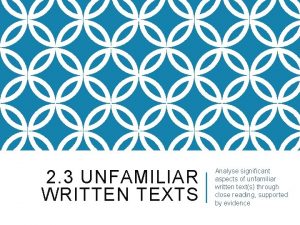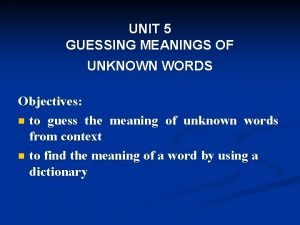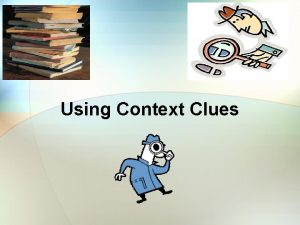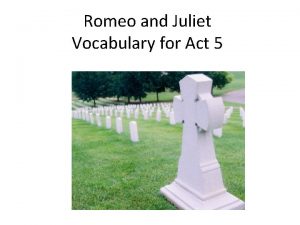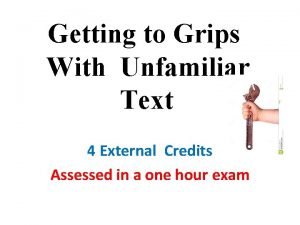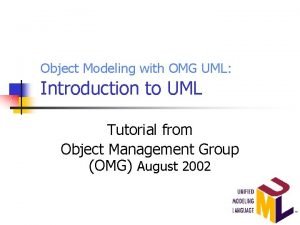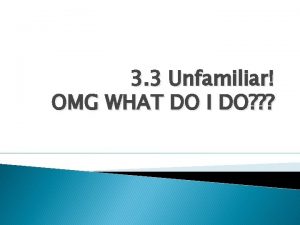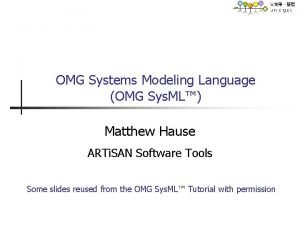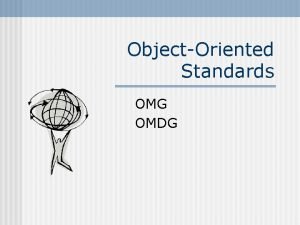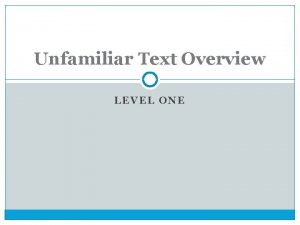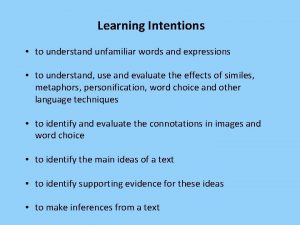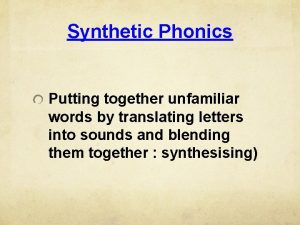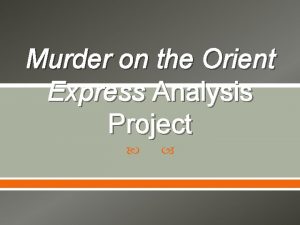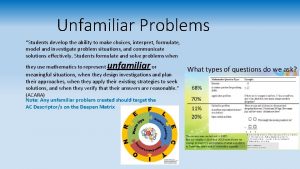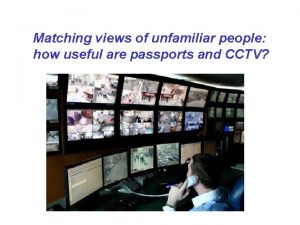3 3 Unfamiliar OMG WHAT DO I DO













- Slides: 13

3. 3 Unfamiliar! OMG WHAT DO I DO? ? ?

First you read it. TWICE at least. each piece before you attempt the questions. Read the piece TWICE. Three times if you are still struggling. YOU DO HAVE TIME! � Read the question CAREFULLY and highlight key words … words like ‘effectiveness’ and in the case of the mouse story ‘irony’ and ‘humour’ � Look to see who wrote the piece. What do you know about them? Where is the story from? This might give you a hint. Hints are good! � Read

Next you highlight stuff! � You will need to identify techniques JUST to achieve – so it doesn’t hurt to highlight some. Annotate the script. Jot down any thoughts that come to you as you go. � For each technique you find note the effect it has – or is supposed to have – on the reader.

Purpose � Why was this piece written? � What is the intended effect on the audience? � You will get some clues on this from where it was published, who wrote it, when it was written and perhaps the title. � No. Nobody writes it ‘just because…’

Point of View � How is the author addressing you? � Does the author use 1 st or 3 rd person? What is the effect of this? � Is this the usual style of writing for this genre? � Why do you think the author chose this style? Does s/he have a point to get across? Is he/she trying to force an opinion on you or merely giving you food for thought?

Positioning of the Reader � Does s/he use the indirect ‘one’ or the more direct ‘you’? What is the effect of this? If it’s ‘one’ s/he is actually including themselves…. � Is the text INCLUSIVE? � Is the author working something out for themselves or asking you to make a decision for them?

Figurative Language � What examples can you find. What is the effect of each example? � What images does the author present? � What is the effect of each image? � Are connotations used at all? How and where? What is the effect of this use? � Are there double meanings? Hidden meanings? � IS the use of figurative language consistent throughout the text?

Vocabulary/Sentence Structure � What specific language does the author use? � What level of formality is it? � What is the effect of using this language? � To whom does this language appeal? � Is there any pattern to the sentences? Are they long, short, a variation? When are they different and why? � How have different sentence types been used and what is the effect of this?

Structure � What does the piece LOOK like? Is it set out in stanzas? Paragraphs? Parts? Dialogue? One big block of text? What is the effect of the layout? � What purpose do the parts or paragraphs play? Is there a specific pattern to the structure? What is the effect of this? � Are things repeated? What is the effect of this?

Marking the Mouse story Not Achieved � The candidate does not identify an example of humour/irony but may give an example of a � language technique OR may identify an example of humour but does not give any language � technique. � The candidate: � • identifies a technique in the column and gives an example � • the example of a language technique may have a tenuous link to the effect of the irony/humour.

Achievement � � � � � � identifies some aspect of humour or irony and gives an example of at least ONE valid language technique • makes a relevant comment about how the language technique is effective. Eg Bennett inflates the image of the mouse as much more powerful than it actually is through hyperbole. ‘It was alert but not nervous, a tiny suburban antelope on the carpet’s Serengeti, ’ he writes. He sees it in exaggerated terms (‘antelope’) and describes the carpet as a National Park. The effect is to show he appreciated the mouse’s beauty, and so it prepares us for his strange ‘communion’. The candidate: • identifies some aspect of humour and irony and gives an example of at least TWO valid language techniques • makes a relevant comment about how the language techniques used for humour and irony are effective in revealing the writer as a slothful young man or ruthless middle-aged one. Eg Bennett inflates the carpet of the house as something much bigger than it actually is (‘Serengeti’, a National Park), and an ordinary New Zealand mouse into an antelope. This is humorous, especially since it may be caused by his persisting ‘hangover’. There is humour in the generalised nickname ‘Mrs Whangarei’, suggesting that he laughs at himself for becoming so domesticated. There is irony in the fact that his mousetrap “serves as a feeding station” - in contrast to Mrs Whangarei, Bennett is a very poor, impractical housekeeper.

� � � � Merit identifies an aspect of humour and irony and gives an example of at least TWO valid language techniques • presents a valid and detailed discussion of how the techniques are effective in expressing the irony and humour. Eg Bennett begins his discussion by using an amusing anecdote of himself as a young man and a mouse. The mouse comes across as a far more significant figure than we might expect, and Bennett has deliberately exaggerated the mouse’s size to be a significant animal (‘antelope’) in a significant place (‘Serengeti’). He doesn’t see the mouse as vermin at all, but as something noble and beautiful which he had ‘communion’ with. This bonding changes when he is middle-aged. He laughs at himself for becoming a typical mouse catcher to show different he is now in middle-age. He wants to destroy the mouse and with the deadly device of ‘Mrs Whangarei’ he is able to do so. The purpose of the humour is to characterise himself in an amusing light (in a gently self-deprecating tone) at the way he has changed, becoming more practical and less imaginative, as he has got older. M 6 • identifies an aspect of humour and irony and gives an example of at least TWO valid language techniques • presents a valid, detailed, AND discerning critical discussion of how the techniques are effective in expressing humour and irony • demonstrates a convincing awareness of the effects of irony and humour. Eg The passage is full of irony and humour, because the purpose of the piece is to use two insignificant domestic events involving mice to tell the reader of the difference between youth and middle-age regarding home-making issues. Firstly, the language used makes the mouse seem like a much larger animal in a National park (an ‘antelope’ in ‘Serengeti’). What we really learn is that he couldn’t care less about the mouse when he was young. Later he again uses humour (through hyperbole or exaggeration) to describe the mouse that ‘hillaries’ up the back of the fridge, the neologism making the mouse a mountaineer who nightly reaches the top of Everest/the world/the fridge. He enjoys describing the mousetrap ‘as touchy as a feminist’ showing he is not politically correct. The moral of the two anecdotes is ironic: he was once an imaginative, sensitive young man who has become domesticated, cold and practical in middle-age.

� � � � � Excellence • identifies techniques associated with irony and humour and gives an example of at least TWO valid language techniques (at least one of each) • presents an insightful and discerning critical discussion of how the techniques are effective as ways of presenting irony and humour • demonstrates an integrated and perceptive awareness of the links between irony and humour and their effects. Eg The writer begins with his theme: time passes and things change. This statement of theme initiates two stories of mice that allow the writer to reveal in ironic language that he is a different man in middle-age from what he was in his youth. Originally he describes himself as fascinated by the mouse, which he inflates into a large animal in a National Park. Strangely, he senses a kinship (‘a communion of sorts’) with the mouse. ‘Communion’ is a word used to describe something important and exalted and here it describes the reverent, tender relationship between the writer and the mouse. Eventually, however, he becomes exactly the opposite in attitude to the mouse. Although he again exaggerates the mouse’s size (now he is a Hillary scaling to the top of the world/fridge nightly), he has no kinship feelings towards it: coldly and pragmatically, he eliminates it. But he is aware of the ironic ‘gap’ or contradiction between the cold grown-up and the youthful, idealistic dreamer. • identifies techniques associated with irony and humour and gives an example of at least TWO valid language techniques (at least one of each) • presents an insightful, sophisticated and discerning critical discussion of how the technique is effective in expressing the irony and humour • demonstrates an integrated and perceptive awareness of the links between irony and humour as effective ways of expressing his ideas. Eg The title of the text alludes to Charles Dickens’s novel, A Tale of Two Cities, while the word “mice” alerts us to the possibility that this will be a serious fable. The first and last sentences support this idea, because they indicate the moral of the fable. Although Bennett’s message is serious, it comes from everyday incidents and details, recounted in a light, casual, breezy and humorous way. This makes the lesson/moral easy for all types of readers to digest, which is appropriate for a newspaper column. In his first anecdote, the encounter seems exaggerated and comic to us (and maybe also to the older, wiser Bennett), but it was hugely meaningful for him at the time. This is ironic, considering the surroundings were squalid and he was a typical, slovenly young man with a hangover, looking at an ordinary mouse. In the second anecdote, the exaggerated view of the noble mouse-mountaineer contrasts ironically with his violent, very messy end. An additional irony is that while the narrator finally achieves competence as a pest exterminator, he has lost his youthful innocence and wonder at the world.
